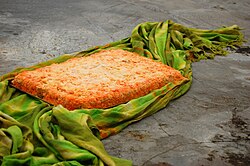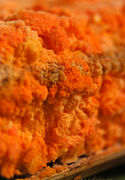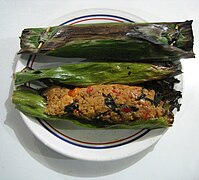Oncom
 A block of red oncom | |
| Course | Main course |
|---|---|
| Place of origin | Indonesia |
| Region or state | West Java |
| Associatedcuisine | Indonesia |
Oncom(IPA:ɔnˈtʃɔm) is one of the traditionalstaple foodsofthe SundanesecuisineofIndonesia.There are two kinds of oncom:red oncomandblack oncom.Oncom is closely related totempeh;both are foodsfermentedusingmold.[1]
Usually, oncom is made from theby-productsfrom the production of other foods:soy pulpremains from makingtofu,peanutpress cakeremains after theoilhas beenpressed out,cassavatailings when extracting thestarch(pati singkong),coconutpress cake remaining after the oil has been pressed out or whencoconut milkhas been produced. Since oncom production usesby-productsto make food, it increases theeconomic efficiencyoffood production.
Black oncom is made by usingRhizopus oligosporuswhile red oncom is made by usingNeurospora intermediavar.oncomensis.[2]It is the only traditional human food produced fromNeurospora.
Red oncom has been found to reduce thecholesterol levelsof rats.[3]
Toxicity
[edit]In the production of oncom, sanitation and hygiene are important to avoid contaminating the culture withbacteriaor otherfungilikeAspergillus flavus(which producesaflatoxin).Neurospora intermedia var. oncomensisandRhizopus oligosporusreduce the aflatoxin produced byAspergillus flavus.[4]However, aflatoxin-producing molds (Aspergillusspp.) are often naturally present on peanut press cake. Furthermore, coconut press cake can harbor the very dangerousBurkholderia gladioli,which produces two highly toxic compounds –bongkrek acidandtoxoflavin.William Shurtleffand Akiko Aoyagi address toxicity in theirbook section on oncom.
While it is known thatsoybeansare the best substrate for growingR. oligosporusto producetempeh,oncom has not been as thoroughly studied; the best fermentation substrates for producing oncom are not yet known.[citation needed]
Cooking methods
[edit]Oncom can be prepared and cooked in various ways. It can be simply deep fried asgorenganfritters, seasoned and cooked in abanana leafpouch aspepes,or roasted, seasoned, and mixed with steamed rice asnasi tutug oncom.[5]Oncom is also a selected filling forcomro,lontongandarem-aremrice dumplings.Comroin particular is a popularSundanesesnack, the name was an abbreviation ofoncom di jerowhich means "oncom inside".[6]
Gallery
[edit]-
Closer view of red oncom mold
-
Oncom cooked aspepesdish.
-
Nasi tutug oncom,roasted oncom mashed with steamed rice, served with side dishes.
See also
[edit]References
[edit]- ^Sastraatmadja, D. D.; et al. (2002). "Production of High-Quality Oncom, a Traditional Indonesian Fermented Food, by the Inoculation with Selected Mold Strains in the Form of Pure Culture and Solid Inoculum".Journal of the Graduate School of Agriculture, Hokkaido University.70:111–127.CiteSeerX10.1.1.866.6352.hdl:2115/13163.
- ^Ho, C.C. (1986). "Identity and characteristics of Neurospora intermedia responsible for oncom fermentation in Indonesia".Food Microbiology.3(2): 115–132.doi:10.1016/S0740-0020(86)80035-1.
- ^"Plasma cholesterol reduction by defatted soy ontjom (fermented with Neurospora intermedia) in rats fed a cholesterol-free diet".usda.gov.Archived fromthe originalon 19 July 2009.Retrieved25 March2019.
- ^Nout, M.J.R. (December 1989)."Effect of Rhizopus and Neurospora spp. on growth of Aspergillus flavus and A. parasiticus and accumulation of aflatoxin B1 in groundnut".Mycological Research.93(4): 518–523.doi:10.1016/S0953-7562(89)80046-2.
- ^"Seven traditional Indonesian rice dishes you should try".The Jakarta Post.Retrieved2020-04-07.
- ^"Serupa Namun Tak Sama, Ini Perbedaan Combro dan Misro".Kumparan(in Indonesian).Retrieved2020-04-07.
Further reading
[edit]- Aoyagi; Shurtleff (1979)."Appendix H Onchom or Ontjom".Book of Tempeh(Professional ed.). Soyinfo Center.ISBN9780060140090.




